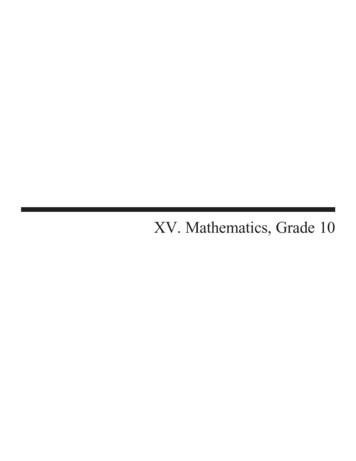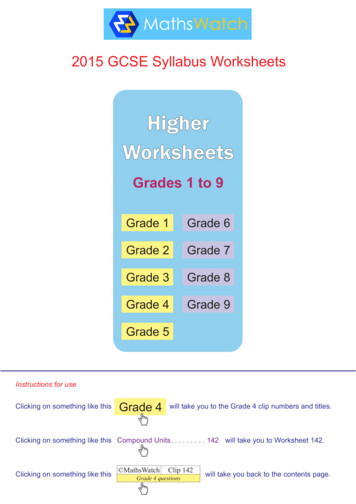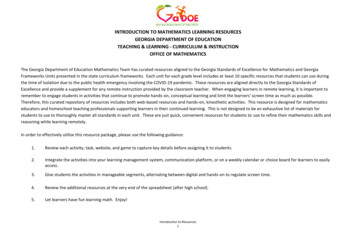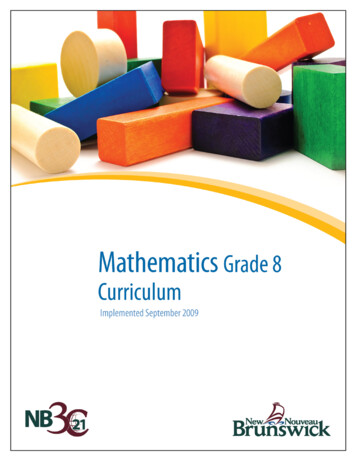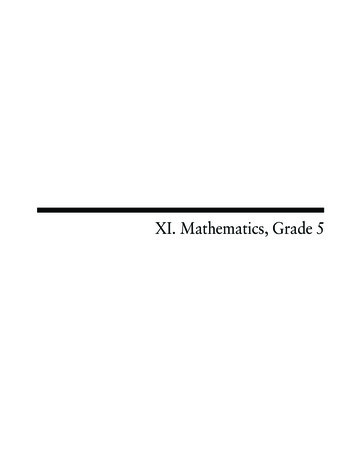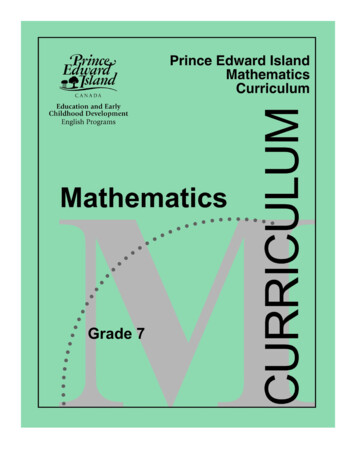
Transcription
ACKNOWLEDGMENTSAcknowledgmentsThe Department of Education and Early Childhood Development of Prince Edward Island gratefullyacknowledges the contributions of the following groups and individuals toward the development of thePrince Edward Island Grade 7 Mathematics Curriculum Guide: The following specialists from the Prince Edward Island Department of Education and EarlyChildhood Development:J. Blaine Bernard,Secondary Mathematics Specialist,Department of Education andEarly Childhood DevelopmentBill MacIntyre,Elementary Mathematics/Science Specialist,Department of Education andEarly Childhood DevelopmentEric Arseneault,Secondary French Math/Science Specialist,Department of Education andEarly Childhood DevelopmentJonathan Hayes,Secondary Science Specialist,Department of Education andEarly Childhood DevelopmentThe 2008-2009 grade seven mathematics pilot teachers:Cheryl Arsenault,Hernewood Intermediate SchoolSheryll O’Hanley,St. Peters Consolidated SchoolJacqueline Gallant,Hernewood Intermediate SchoolLincoln Rix,Hernewood Intermediate SchoolAndrea Horrelt,Stonepark Intermediate SchoolDavid Shellington,Stonepark Intermediate SchoolDarcy McCourt,Stonepark Intermediate SchoolTabitha Somers,Stonepark Intermediate SchoolJacqueline McIver,Athena Consolidated SchoolSandy Stratton,Stonepark Intermediate SchoolLaura Montgomery,Hernewood Intermediate SchoolLawrence Young,Stonepark Intermediate School The Western and Northern Canadian Protocol (WNCP) for Collaboration in Education Alberta Education New Brunswick Department of EducationPRINCE EDWARD ISLAND GRADE 7 MATHEMATICS CURRICULUM GUIDEi
TABLE OF CONTENTSTable of ContentsBackground and Rationale. 1Essential Graduation Learnings. 1Curriculum Focus . 2Connections across the Curriculum . 2Conceptual Framework for K-9 Mathematics. 3Mathematical Processes. 4The Nature of Mathematics. 7Contexts for Learning and Teaching . 10Homework . 10Diversity in Student Needs. 11Gender and Cultural Diversity. 11Mathematics for EAL Learners . 11Education for Sustainable Development. 12Assessment and Evaluation . 13Assessment. 13Evaluation . 15Reporting. 15Guiding Principles . 15Structure and Design of the Curriculum Guide . 17Specific Curriculum Outcomes. 18Number . 18Patterns and Relations. 34Shape and Space. 50Statistics and Probability. 62Curriculum Guide Supplement . 77Unit Plans. 79Chapter 1 Coordinates and Design . 79Chapter 2 Operations on Decimal Numbers. 85Chapter 3 Geometry and Measurement . 91Chapter 4 Fractions, Decimals and Percents . 97Chapter 5 Probability . 101Chapter 6 Introduction to Fraction Operations . 107Chapter 7 Add and Subtract Fractions . 111Chapter 8 Circles . 117Chapter 9 Add and Subtract Integers . 123Chapter 10 Patterns and Expressions . 129Chapter 11 Solving Equations . 135Chapter 12 Working with Data. 141Glossary of Mathematical Terms. 147Solutions to Possible Assessment Strategies. 153References . 167PRINCE EDWARD ISLAND GRADE 7 MATHEMATICS CURRICULUM GUIDEii
BACKGROUND AND RATIONALEBackground and RationaleThe development of an effective mathematics curriculum has encompassed a solid research base.Developers have examined the curriculum proposed throughout Canada and secured the latest researchin the teaching of mathematics, and the result is a curriculum that should enable students to understandand use mathematics.The Western and Northern Canadian Protocol (WNCP) Common Curriculum Framework for K-9Mathematics (2006) has been adopted as the basis for a revised mathematics curriculum in PrinceEdward Island. The Common Curriculum Framework was developed by the seven Canadian westernand northern ministries of education (British Columbia, Alberta, Saskatchewan, Manitoba, YukonTerritory, Northwest Territories, and Nunavut) in collaboration with teachers, administrators, parents,business representatives, post-secondary educators, and others. The framework identifies beliefs aboutmathematics, general and specific student outcomes, and achievement indicators agreed upon by theseven jurisdictions. This document is based on both national and international research by the WNCP,and on the Principles and Standards for School Mathematics (2000), published by the National Council ofTeachers of Mathematics (NCTM). Essential Graduation LearningsEssential graduation learnings (EGLs) are statements describing the knowledge, skills, and attitudesexpected of all students who graduate from high school. Achievement of the essential graduationlearnings will prepare students to continue to learn throughout their lives. These learnings describeexpectations not in terms of individual school subjects but in terms of knowledge, skills, and attitudesdeveloped throughout the curriculum. They confirm that students need to make connections and developabilities across subject boundaries if they are to be ready to meet the shifting and ongoing demands oflife, work, and study today and in the future. Essential graduation learnings are cross curricular, andcurriculum in all subject areas is focussed to enable students to achieve these learnings. Essentialgraduation learnings serve as a framework for the curriculum development process.Specifically, graduates from the public schools of Prince Edward Island will demonstrate knowledge,skills, and attitudes expressed as essential graduation learnings, and will be expected to respond with critical awareness to various forms of the arts, and be able to expressthemselves through the arts; assess social, cultural, economic, and environmental interdependence in a local andglobal context; use the listening, viewing, speaking, and writing modes of language(s), and mathematicaland scientific concepts and symbols, to think, learn, and communicate effectively; continue to learn and to pursue an active, healthy lifestyle; use the strategies and processes needed to solve a wide variety of problems, includingthose requiring language and mathematical and scientific concepts; use a variety of technologies, demonstrate an understanding of technologicalapplications, and apply appropriate technologies for solving problems.More specifically, curriculum outcome statements articulate what students are expected to know and beable to do in particular subject areas. Through the achievement of curriculum outcomes, studentsdemonstrate the essential graduation learnings.PRINCE EDWARD ISLAND GRADE 7 MATHEMATICS CURRICULUM GUIDEPage 1
BACKGROUND AND RATIONALE Curriculum FocusThere is an emphasis in the Prince Edward Island mathematics curriculum on particular key concepts ateach grade which will result in greater depth of understanding. There is also more emphasis on numbersense and operations in the early grades to ensure students develop a solid foundation in numeracy. Theintent of this document is to clearly communicate to all educational partners high expectations forstudents in mathematics education. Students must learn mathematics with understanding, activelybuilding new knowledge from experience and prior knowledge (NCTM Principles and Standards forSchool Mathematics, 2000).The main goals of mathematics education are to prepare students to use mathematics confidently to solve problems;communicate and reason mathematically;appreciate and value mathematics;make connections between mathematics and its applications;commit themselves to lifelong learning;become mathematically literate adults, using mathematics to contribute to society.Students who have met these goals will gain understanding and appreciation of the contributions of mathematics as a science,philosophy, and art;exhibit a positive attitude toward mathematics;engage and persevere in mathematical tasks and projects;contribute to mathematical discussions;take risks in performing mathematical tasks;exhibit curiosity. Connections across the CurriculumThe teacher should take advantage of the various opportunities available to integrate mathematics andother subjects. This integration not only serves to show students how mathematics is used in daily life,but it helps strengthen the understanding of mathematical concepts by students and provides them withopportunities to practise mathematical skills. There are many possibilities for integrating mathematics inliteracy, science, social studies, music, art, physical education, and other subject areas. Efforts should bemade to make connections and use examples drawn from a variety of disciplines.PRINCE EDWARD ISLAND GRADE 7 MATHEMATICS CURRICULUM GUIDEPage 2
CONCEPTUAL FRAMEWORK FOR K-9 MATHEMATICSConceptual Framework for K-9 MathematicsThe chart below provides an overview of how mathematical processes and the nature of mathematicsinfluence learning outcomes.GRADEK123456789STRANDNumberPatterns and Relations Patterns Variables and EquationsShape and Space Measurement 3-D Objects and 2-D Shapes TransformationsGENERALCURRICULUM OUTCOMES (GCOs)SPECIFICCURRICULUM OUTCOMES (SCOs)ACHIEVEMENT INDICATORSStatistics and Probability Data Analysis Chance and UncertaintyMATHEMATICAL PROCESSESNATUREOFMATHEMATICSChangeConstancyNumber SensePatternsRelationshipsSpatial SenseUncertaintyCommunication, Connections,Reasoning, Mental Mathematicsand Estimation, Problem Solving,Technology, VisualizationThe mathematics curriculum describes the nature of mathematics, as well as the mathematical processesand the mathematical concepts to be addressed. This curriculum is arranged into four strands, namelyNumber, Patterns and Relations, Shape and Space, and Statistics and Probability. These strands are notintended to be discrete units of instruction. The integration of outcomes across strands makesmathematical experiences meaningful. Students should make the connections among concepts bothwithin and across strands. Consider the following when planning for instruction: Integration of the mathematical processes within each strand is expected. Decreasing emphasis on rote calculation, drill, and practice, and the size of numbersused in paper and pencil calculations makes more time available for conceptdevelopment. Problem solving, reasoning, and connections are vital to increasing mathematical fluency,and must be integrated throughout the program. There is to be a balance among mental mathematics and estimation, paper and pencilexercises, and the use of technology, including calculators and computers. Conceptsshould be introduced using models and gradually developed from the concrete to thepictorial to the symbolic.PRINCE EDWARD ISLAND GRADE 7 MATHEMATICS CURRICULUM GUIDEPage 3
CONCEPTUAL FRAMEWORK FOR K-9 MATHEMATICS Mathematical ProcessesThere are critical components that students must encounter in a mathematics program in order to achievethe goals of mathematics education and encourage lifelong learning in mathematics. The Prince EdwardIsland mathematics curriculum incorporates the following seven interrelated mathematical processes thatare intended to permeate teaching and learning. These unifying concepts serve to link the content tomethodology.Students are expected to communicate in order to learn and express their understanding of mathematics;[Communications: C] connect mathematical ideas to other concepts in mathematics, to everyday experiences,and to other disciplines; [Connections: CN] demonstrate fluency with mental mathematics and estimation; [Mental Mathematics andEstimation: ME] develop and apply new mathematical knowledge through problem solving; [ProblemSolving: PS] develop mathematical reasoning; [Reasoning: R] select and use technologies as tools for learning and solving problems; [Technology: T] develop visualization skills to assist in processing information, making connections, andsolving problems. [Visualization: V]Communication [C]Students need opportunities to read about, represent, view, write about, listen to, and discussmathematical ideas. These opportunities allow students to create links between their own language andideas and the formal language and symbols of mathematics. Communication is important in clarifying,reinforcing, and modifying ideas, knowledge, attitudes, and beliefs about mathematics. Students shouldbe encouraged to use a variety of forms of communication while learning mathematics. Students alsoneed to communicate their learning using mathematical terminology. Communication can help studentsmake connections among concrete, pictorial, symbolic, verbal, written, and mental representations ofmathematical ideas.Connections [CN]Contextualization and making connections to the experiences of learners are powerful processes indeveloping mathematical understanding. When mathematical ideas are connected to each other or toreal-world phenomena, students can begin to view mathematics as useful, relevant, and integrated.Learning mathematics within contexts and making connections relevant to learners can validate pastexperiences and increase student willingness to participate and be actively engaged. The brain isconstantly looking for and making connections.For instance, opportunities should be created frequently to link mathematics and career opportunities.Students need to become aware of the importance of mathematics and the need for mathematics in manycareer paths. This realization will help maximize the number of students who strive to develop andmaintain the mathematical abilities required for success in further areas of study.PRINCE EDWARD ISLAND GRADE 7 MATHEMATICS CURRICULUM GUIDEPage 4
CONCEPTUAL FRAMEWORK FOR K-9 MATHEMATICSMental Mathematics and Estimation [ME]Mental mathematics is a combination of cognitive strategies that enhance flexible thinking and numbersense. It involves calculation without the use of external memory aids. Mental mathematics enablesstudents to determine answers without paper and pencil. It improves computational fluency bydeveloping efficiency, accuracy, and flexibility. Even more important than performing computationalprocedures or using calculators is the greater facility that students need - more than ever before - withestimation and mental mathematics (National Council of Teachers of Mathematics, May 2005). Studentsproficient with mental mathematics “become liberated from calculator dependence, build confidence indoing mathematics, become more flexible thinkers and are more able to use multiple approaches toproblem solving” (Rubenstein, 2001). Mental mathematics “provides a cornerstone for all estimationprocesses offering a variety of alternate algorithms and non-standard techniques for finding answers”(Hope, 1988).Estimation is a strategy for determining approximate values or quantities, usually by referring tobenchmarks or using referents, or for determining the reasonableness of calculated values. Studentsneed to know when to estimate, what strategy to use, and how to use it. Estimation is used to makemathematical judgments and develop useful, efficient strategies for dealing with situations in daily life.Students need to develop both mental mathematics and estimation skills through context and not inisolation so they are able to apply them to solve problems. Whenever a problem requires a calculation,students should follow the decision-making process described below:Problem SituationCalculation RequiredApproximateAnswer AppropriateExact AnswerNeededUse MentalCalculationUse Paperand PencilUse aCalculator/ComputerEstimate(NCTM)Problem Solving [PS]Learning through problem solving should be the focus of mathematics at all grade levels. When studentsencounter new situations and respond to questions of the type, “How would you. . . ?" or “How couldyou. . . ?” the problem-solving approach is being modelled. Students develop their own problem-solvingstrategies by being open to listening, discussing, and trying different strategies.In order for an activity to be problem-solving based, it must ask students to determine a way to get fromwhat is known to what is sought. If students have already been given ways to solve the problem, it is notPRINCE EDWARD ISLAND GRADE 7 MATHEMATICS CURRICULUM GUIDEPage 5
CONCEPTUAL FRAMEWORK FOR K-9 MATHEMATICSa problem, but practice. A true problem requires students to use prior learning in new ways and contexts.Problem solving requires and builds depth of conceptual understanding and student engagement.Problem solving is also a powerful teaching tool that fosters multiple, creative, and innovative solutions.Creating an environment where students openly look for and engage in finding a variety of strategies forsolving problems empowers students to explore alternatives and develops confident and cognitivemathematical risk takers.Over time, numerous problem-solving strategies should be modelled for students, and students should beencouraged to employ various strategies in many problem-solving situations. While choices with respectto the timing of the introduction of any given strategy will vary, the following strategies should all becomefamiliar to students: using estimationguessing and checkinglooking for a patternmaking an organized list or tableusing a model working backwardsusing a formulausing a graph, diagram, or flow chartsolving a simpler problemusing algebra.Reasoning [R]Mathematical reasoning helps students think logically and make sense of mathematics. Students need todevelop confidence in their abilities to reason and justify their mathematical thinking. High-orderquestions challenge students to think and develop a sense of wonder about mathematics. Mathematicalexperiences in and out of the classroom provide opportunities for inductive and deductive reasoning.Inductive reasoning occurs when students explore and record results, analyse observations, makegeneralizations from patterns, and test these generalizations. Deductive reasoning occurs when studentsreach new conclusions based upon what is already known or assumed to be true.Technology [T]Technology contributes to the learning of a wide range of mathematical outcomes and enables studentsto explore and create patterns, examine relationships, test conjectures, and solve problems.Calculators and computers can be used to explore and demonstrate mathematical relationships and patterns;organize and display data;extrapolate and interpolate;assist with calculation procedures as part of solving problems;decrease the time spent on computations when other mathematical learning is the focus;reinforce the learning of basic facts and test properties;develop personal procedures for mathematical operations;create geometric displays;simulate situations;develop number sense.Technology contributes to a learning environment in which the growing curiosity of students can lead torich mathematical discoveries at all grade levels. While technology can be used in K-3 to enrich learning,it is expected that students will meet all outcomes without the use of technology.PRINCE EDWARD ISLAND GRADE 7 MATHEMATICS CURRICULUM GUIDEPage 6
CONCEPTUAL FRAMEWORK FOR K-9 MATHEMATICSVisualization [V]Visualization involves thinking in pictures and images, and the ability to perceive, transform, and recreatedifferent aspects of the visual-spatial world. The use of visualization in the study of mathematics providesstudents with opportunities to understand mathematical concepts and make connections among them.Visual images and visual reasoning are important components of number, spatial, and measurementsense. Number visualization occurs when students create mental representations of numbers.Being able to create, interpret, and describe a visual representation is part of spatial sense and spatialreasoning. Spatial visualization and reasoning enable students to describe the relationships among andbetween 3-D objects and 2-D shapes.Measurement visualization goes beyond the acquisition of specific measurement skills. Measurementsense includes the ability to determine when to measure and when to estimate, and knowledge of severalestimation strategies (Shaw & Cliatt, 1989).Visualization is fostered through the use of concrete materials, technology, and a variety of visualrepresentations. The Nature of MathematicsMathematics is one way of trying to understand, interpret, and describe our world. There are a number ofcomponents that define the nature of mathematics which are woven throughout this document. Thesecomponents include change, constancy, number sense, patterns, relationships, spatial sense, anduncertainty.ChangeIt is important for students to understand that mathematics is dynamic and not static. As a result,recognizing change is a key component in understanding and developing mathematics. Withinmathematics, students encounter conditions of change and are required to search for explanations of thatchange. To make predictions, students need to describe and quantify their observations, look forpatterns, and describe those quantities that remain fixed and those that change. For example, thesequence 4, 6, 8, 10, 12, can be described as skip counting by 2s, starting from 4;an arithmetic sequence, with first term 4 and a common difference of 2; ora linear function with a discrete domain.ConstancyDifferent aspects of constancy are described by the terms stability, conservation, equilibrium, steadystate, and symmetry (AAAS–Benchmarks, 1993, p. 270). Many important properties in mathematics andscience relate to properties that do not change when outside conditions change. Examples of constancyinclude the following: The area of a rectangular region is the same regardless of the methods used todetermine the solution.The sum of the interior angles of any triangle is 1800.The theoretical probability of flipping a coin and getting heads is 0.5.Some problems in mathematics require students to focus on properties that remain constant. Therecognition of constancy enables students to solve problems involving constant rates of change, lineswith constant slope, direct variation situations, or the angle sums of polygons.PRINCE EDWARD ISLAND GRADE 7 MATHEMATICS CURRICULUM GUIDEPage 7
CONCEPTUAL FRAMEWORK FOR K-9 MATHEMATICSNumber SenseNumber sense, which can be thought of as intuition about numbers, is the most important foundation ofnumeracy (The Primary Program, B.C., 2000, p. 146). A true sense of number goes well beyond theskills of simply counting, memorizing facts, and the situational rote use of algorithms. Number sensedevelops when students connect numbers to real-life experiences, and use benchmarks and referents.This results in students who are computationally fluent, and flexible and intuitive with numbers. Theevolving number sense typically comes as a by-product of learning rather than through direct instruction.However, number sense can be developed by providing rich mathematical tasks that allow students tomake connections.PatternsMathematics is about recognizing, describing, and working with numerical and non-numerical patterns.Patterns exist in all strands and it is important that connections are made among strands. Working withpatterns enables students to make connections within and beyond mathematics. These skills contributeto students’ interaction with and understanding of their environment. Patterns may be represented inconcrete, visual, or symbolic form. Students should develop fluency in moving from one representation toanother. Students must learn to recognize, extend, create, and use mathematical patterns. Patternsallow students to make predictions and justify their reasoning when solving routine and non-routineproblems. Learning to work with patterns in the early grades helps develop students’ algebraic thinkingthat is foundational for working with more abstract mathematics in higher grades.RelationshipsMathematics is used to describe and explain relationships. As part of the study of mathematics, studentslook for relationships among numbers, sets, shapes, objects, and concepts. The search for possiblerelationships involves the collecting and analysing of data, and describing relationships visually,symbolically, orally, or in written form.Spatial SenseSpatial sense involves visualization, mental imagery, and spatial reasoning. These skills are central tothe understanding of mathematics. Spatial sense enables students to interpret representations of 2-Dshapes and 3-D objects, and identify relationships to mathematical strands. Spatial sense is developedthrough a variety of experiences and interactions within the environment. The development of spatialsense enables students to solve problems involving 2-D shapes and 3-D objects.Spatial sense offers a way to interpret and reflect on the physical environment and its 3-D or 2-Drepresentations. Some problems involve attaching numerals and appropriate units (measurement) todimensions of objects. Spatial sense allows students to use dimensions and make predictions about theresults of changing dimensions. Knowing the dimensions of an object enables students to communicate about the objectand create representations.The volume of a rectangular solid can be calculated from given dimensions.Doubling the length of the side of a square increases the area by a factor of four.UncertaintyIn mathematics, interpretations of data and the predictions made from data may lack certainty. Eventsand experiments generate statistical data that can be used to make predictions. It is important torecognize that these predictions (interpolations and extrapolations) are based upon patterns that have adegree of uncertainty. The quality of the interpretation is directly related to the quality of the data. Anawareness of uncertainty allows students to assess the reliability of data and data interpretation. Chanceaddresses the predictability of the occurrence of an outcome. As students develop their understanding ofPRINCE EDWARD ISLAND GRADE 7 MATHEMATICS CURRICULUM GUIDEPage 8
CONCEPTUAL FRAMEWORK FOR K-9 MATHEMATICSprobability, the language of mathematics becomes more specific and describes the degree of uncertaintymore accurately.PRINCE EDWARD ISLAND GRADE 7 MATHEMATICS CURRICULUM GUIDEPage 9
CONTEXTS FOR LEARNING AND TEACHINGContexts for Learning and TeachingThe Prince Edward Island mathematics curriculum is based upon several key assumptions or beliefsabout mathematics learning which have grown out of research and practice: Mathematics learning is an active and constructive process. Learners are individuals who bring a wide range of prior knowledge and experiences, andwho learn via various styles and at different rates. Learning is most likely to occur in meaningful contexts and in an environment thatsupports exploration, risk taking, and critical thinking, and that nurtures positive attitudesand sustained effort. Learning is most effective when standards of expectation are made clear with ongoingassessment and feedback.Students are curious, active learners with individual interests, abilities, and needs. They come toclassrooms with varying knowledge, life experiences, and backgrounds. A key component in successfullydeveloping numeracy is making connections to these backgrounds and experiences.Young children develop a vari
The Department of Education and Early Childhood Development of Prince Edward Island gratefully acknowledges the contributions of the following groups and individuals toward the development of the Prince Edward Island Grade 7 Mathematics Curriculum Guide: The following specialists from the Prince Edward Island Department of Education and Early
